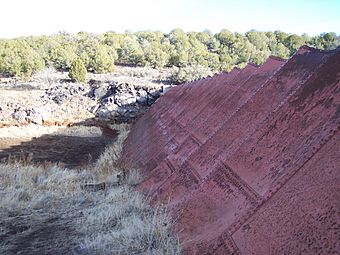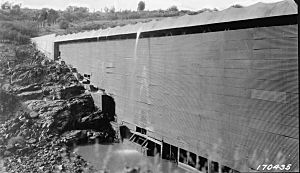Ashfork-Bainbridge Steel Dam facts for kids
Quick facts for kids |
|
|
Ash Fork Steel Dam
|
|

Current view of dam face
|
|
| Location | Coconino County, Arizona |
|---|---|
| Nearest city | Ash Fork, Arizona |
| Built | 1897 |
| Architect | Atchison, Topeka & Santa Fe Railroad |
| Architectural style | Reservoir Dam |
| NRHP reference No. | 76000373 |
| Added to NRHP | July 30, 1976 |
The Ashfork Bainbridge Steel Dam was the first large steel dam ever built. It is also one of only three steel dams ever constructed in the United States! The Atchison, Topeka and Santa Fe Railway (ATSF) built it in 1898. They needed a lot of water for their trains near Ash Fork, Arizona.
The dam is named after the town of Ash Fork. It's also named after Francis H. Bainbridge, a smart civil engineer. He worked for the ATSF. This important dam has been on the National Register of Historic Places since 1976.
Contents
Why Was the Dam Built?
Railroads like the ATSF needed huge amounts of water. Their steam locomotives used a lot of water, especially in dry desert areas. To get water, railroads usually built dams to collect rainwater. They also drilled wells and stored water in big water tanks. Towns often grew around these water stops. Ash Fork was one of these towns.
Railroads were leaders in building new structures. They used to build bridges from masonry (stone and brick). But then they started using steel for bridges. Steel bridges were cheaper, faster to build, and used less material. Francis Bainbridge wondered if they could do the same for dams.
The Ash Fork Dam was very different from typical stone dams. Since Bainbridge knew how to build steel bridges, he thought steel could work for dams too. Steel dams are lighter. Their parts can be made in a factory and then put together easily. This made building the dam much simpler than cutting and setting heavy stones.
How Steel Dams Work
Steel dams use thin steel plates that touch the water. Behind these plates is a strong framework of steel. This framework holds the plates up and sends the water's weight down to the ground. The plates are tilted upwards, away from the water. This design helps the water's weight push down on the support beams. This way, the dam stays strong without bending. People thought these dams would be quicker and cheaper to build than stone dams.
Where is the Dam Located?
The dam is about 3 miles (5 km) east of Ash Fork. It's in a place called Johnson Canyon. It's also about 15 miles (24 km) west of Williams, Arizona. You can find it near the old U.S. Route 66 and Interstate 40. About a mile upstream from this dam is another dam called Stone Dam. That one is made of masonry and was built 13 years later. The Grand Canyon Railway starts in Williams. It branches off the main ATSF line that this dam helped serve.
How Was the Dam Built?
The Wisconsin Bridge and Iron Company made the dam's parts. They shipped them to the site, and workers put them together. Building started in 1897 and finished on March 5, 1898. The whole project cost about $63,519 back then. That's like millions of dollars today!
The dam looks wavy or "scalloped." This is because it's made of 24 curved steel plates. Each plate is about 3/8 of an inch (9.5 mm) thick. These plates slope downwards, away from the water. Some plates are loose, and some are rigid. This helps the dam handle big temperature changes. The temperature can go from 104°F (40°C) in summer to -4°F (-20°C) in winter!
The main steel part of the dam is 184 feet (56 m) long. It's 46 feet (14 m) high. It weighs about 460,000 pounds (208,652 kg). This dam doesn't have a spillway (a channel for water to flow over). Instead, it was built to let up to 6 feet (1.8 m) of water pour right over its top without breaking. When full, the dam can hold about 36 million US gallons (136 million liters) of water.
History of the Dam
The Ash Fork Steel Dam is recognized as an Arizona Historic Civil Engineering Landmark. In 1902, an engineering magazine said the dam was "specially interesting and instructive." This was because it had so many new and experimental features.
In 1955, an expert named George Lamb looked at the dam. He said it looked "as good condition as if it was just built." It's still being used today! This is special because the other two steel dams in the United States are no longer in use.
Today, the Kaibab National Forest owns the dam. They got it through a land exchange. The dam was added to the National Register of Historic Places in 1976.
See Also
- Jackson, Donald C. Great American Bridges and Dams, John Wiley & Sons, New York (USA), ISBN: 0-471-14385-5, 1984; pp. 210–211.
- REYNOLDS, T.S. (1989). "A Narrow Window of Opportunity: the Rise and Fall of the Fixed Steel Dam." Jl Soc. for Industrial Archaeology, Vol. 15, pp. 1–20.
- Historic American Engineering Record (HAER) No. AZ-90, "Ash Fork Steel Dam, Johnson Canyon, Ash Fork, Yavapai County, AZ", 4 data pages
- The dam is shown in the lower illustration on this page, taken from a Rensselaer Polytechnic Institute "works of graduates" booklet from 1931. The illustration is an in progress shot. Notation "Designed and patented by F. H. Bainbridge '94" at bottom.




